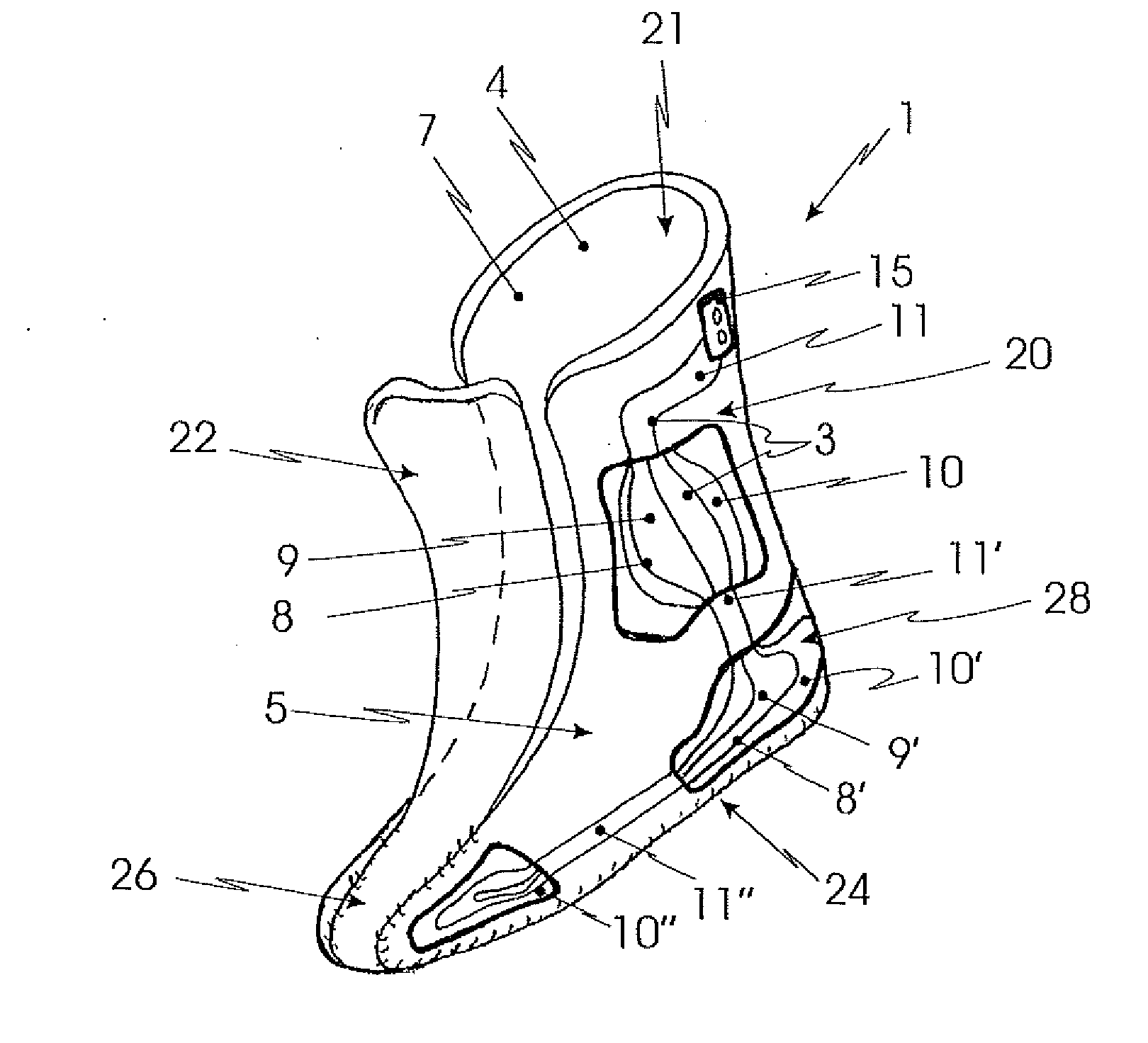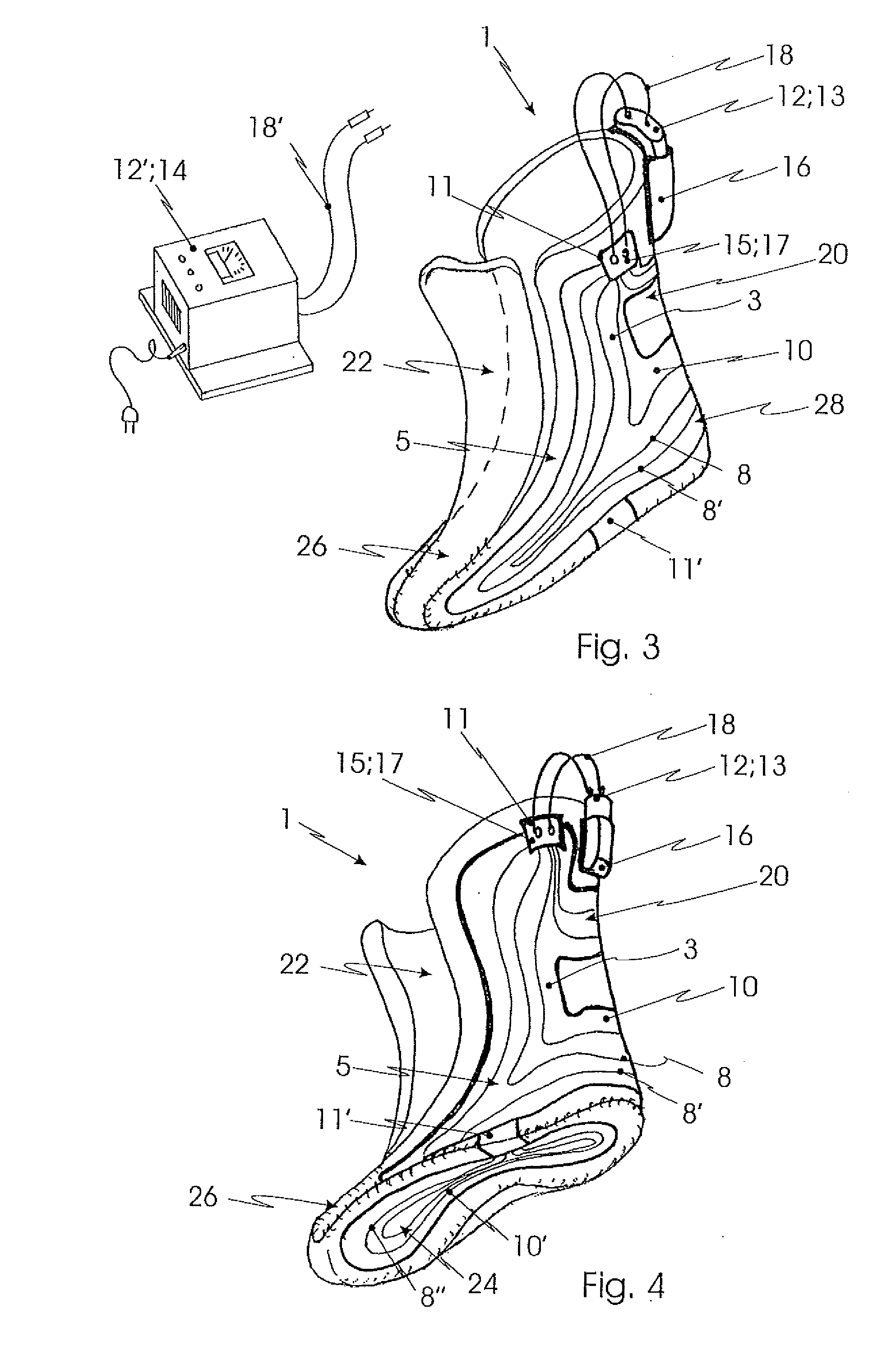Boot liner
a technology for boots and linings, applied in the field of boots, can solve problems such as heat generation of boot liners, and achieve the effects of convenient thermoplastic deformation, simple structure, and improved heat dissipation
- Summary
- Abstract
- Description
- Claims
- Application Information
AI Technical Summary
Benefits of technology
Problems solved by technology
Method used
Image
Examples
first embodiment
[0030]FIGS. 1 and 2 show the boot liner 1 according to the invention. In this case it is made of a basic material 4 of foam, to which an inner lining 7 has been applied in the inner region 21 of the boot liner 1. The boot liner 1 in this case is made, by way of example, from an upper 20 and a tongue 22 which, by way of a forefoot region 26 and a heel region 28, merge into a sole region 24.
[0031]For optimum adaptation of the boot liner 1 to a wearer's foot, it is made at least in part of a thermoplastic basic material 4 which, by means of heating to a predetermined deformation temperature Tv, in this case about 100-120 degrees Celsius, can be made plastically deformable. As soon as the wearer steps into the boot liner 1, the latter starts to adapt to the external contour of the foot. In this case it is possible to provide the boot liner 1 with a plastically deformable material only in particular regions or also, however, as is the case here, for it to be made in its entirety from suc...
third embodiment
[0043]FIG. 5 shows a partial section through the boot liner 1 according to the invention, with its also being possible for the basic structure shown in this case to be applied to the embodiments shown hereinbefore. In this case the boot liner 1 is made of a multi-layered basic material 4, especially from an outer layer 33 and an inner layer 34, which in this case are made of different, yet still thermoplastically deformable materials. It is accordingly possible, for example, for the outer layer 33 to be constructed as a relatively hard layer, which then acts as a primary supporting layer, and the inner layer 34 to be constructed as a relatively soft, or lining, layer. By way of example, the boot liner 1 has already been inserted in this case into an outer boot 30, for example a ski boot or work boot.
[0044]In order, then, to make possible thermoplastic deformation of the boot liner 1 and optimum adaptation to the wearer's foot 32, the heating element 3 is integrated between the outer...
fourth embodiment
[0046]Finally, FIG. 6 shows a fourth embodiment, also in partial section, the boot liner 1 having already been inserted in an outer boot 30 in this case too. The boot liner 1 in this case is made of a basic material 4, to the inside 19 of which there has been applied an inner lining 7. In the main regions, this inner lining 7 is in contact with the wearer's foot 32.
[0047]In this embodiment, the electrical heating element 3 is integrated into the inner lining 7, the electrically conductive threads 8 in this case having been so woven together with non-conductive threads that there is formed an inner lining 7 which in sub-regions is electrically heatable and in other sub-regions is merely electrically conductive. In this context, the use of additional covering layers is also feasible, which are arranged especially between the foot 32 at the inner lining 7 in order to increase comfort during wear and in addition to ensure electrical insulation of the electrical heating element. Explicit...
PUM
 Login to View More
Login to View More Abstract
Description
Claims
Application Information
 Login to View More
Login to View More - R&D
- Intellectual Property
- Life Sciences
- Materials
- Tech Scout
- Unparalleled Data Quality
- Higher Quality Content
- 60% Fewer Hallucinations
Browse by: Latest US Patents, China's latest patents, Technical Efficacy Thesaurus, Application Domain, Technology Topic, Popular Technical Reports.
© 2025 PatSnap. All rights reserved.Legal|Privacy policy|Modern Slavery Act Transparency Statement|Sitemap|About US| Contact US: help@patsnap.com



